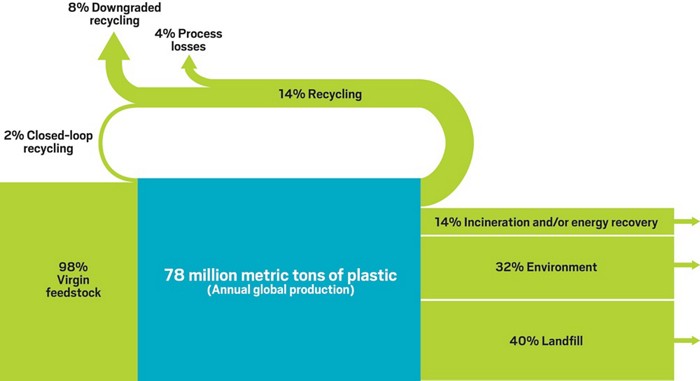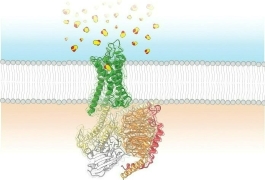Recycling Needs a Revamp
By Sam Lemonick
What could be easier than recycling? Almost everywhere you go these days, there’s a convenient bin for your empty water bottle.
Yet plastic trash continues to accumulate in the environment. A 2015 study in Science estimated that the oceans may hold 155 million metric tons of plastic by 2025, double the current amount (DOI: 10.1126/science.1260352). Turns out those convenient recycling bins aren’t always being used. Americans are doing better than ever but still submit only about one-third of their plastic waste for recycling.
An even more fundamental problem with plastics becomes apparent if you look past the recycling bin. Only about 10% of plastic packaging worldwide—as well as in the U.S.—ends up getting remade into a new product, according to a 2016 World Economic Forum report. Another 14% from around the globe is burned, sometimes to generate energy. And the rest ends up in a landfill or the environment.
And it stays there, preserved. Plastic’s durability is one reason it has become so widely used. When it becomes trash, however, that durability is a curse. Most plastics are made from fossil-fuel-derived polymers, made of molecular chains that can reach thousands of covalently bonded repeating units.
Of the plastic that does get recycled and reborn, a majority of it ends up in a lower-quality product because the most widespread, popular recycling technology involves mechanically shredding, melting, and re-forming plastics. “Polymers tend to degrade at high temperature,” says Megan Robertson, a chemical engineer at the University of Houston. “So we’re essentially downgrading the material as it’s recycled.” A mere 2% of the plastic that starts out in a drinking water bottle will be recycled into a new plastic bottle. The rest of the plastic that gets recycled typically ends up as carpet fibers or outdoor furniture.
Other factors are exacerbating the plastic pollution problem, particularly in the U.S. China, which has for decades collected and processed recyclable waste from around the world, announced in 2017 that it would limit imports of foreign trash. Now some U.S. waste management facilities have to send recyclable plastic straight to the landfill because there’s not enough domestic recycling capacity. Reflecting a growing awareness of the plastic trash problem, in May the American Chemistry Council announced its goal that by 2040 all plastic packaging used in the U.S. will be recycled or made into other products.

Broken cycle
Eighty-six percent of plastic packaging produced globally is never collected for recycling, according to a 2016 World Economic Forum report. Another 4% is lost during the recycling process, 8% is recycled into lower-quality products like carpet fiber or plastic lumber, and just 2% is recycled into equivalent products.
Sources: World Economic Forum; Ellen MacArthur Foundation
As the mountains of discarded plastic continue to grow, science has begun to offer some solutions. Chemists, including Robertson, are working on new chemical methods to break down current plastics to their building blocks for reuse, and they’re designing new plastics that could be easier to recycle. Researchers are also working slowly toward biocatalyzed plastics recycling, using microbes or enzymes to degrade polymers. In the excitement about Mother Nature playing a possible role in solving the plastics problem, however, some news reports about plastic-munching critters have oversold progress.
Related stories featured in Chemical & Engineering News:
This story first appeared in Chemical & Engineering News. "Recylcing Needs a Revamp." (96) 25, June 15, 2018. https://cen.acs.org/environment/pollution/Recycling-needs-revamp/96/i25




